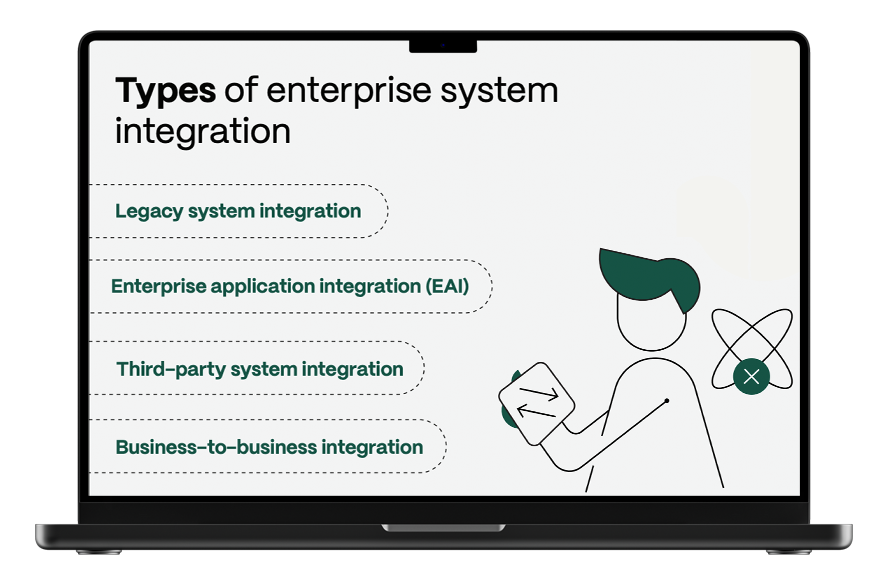System integration best practices: 6 key steps to follow

Creating a system integration is all about connecting different tools into a single, extensive system that works as one. Even if you’re not a tech expert, you can sense how tricky this process can get.
For example, incompatibility issues could arise because individual tools might have different protocols or standards. Data migration and scalability challenges exist, not to mention potential complications if a certain system depends on third-party components or services.
A lot of moving parts and multiple layers of complexity introduce a risk of cost overruns and delays in the integration process. So, what can you do about it? You can follow system integration best practices or partner with someone who knows how to do it – cost-efficiently and on time.
1. Involve all key stakeholders
The very first step is to ensure that you have all relevant stakeholders included in the process. To identify stakeholders, you should assess who will be the most affected by the change and who uses the processes modeled by the system. Once you have those persons identified, you should collect the relevant data and ensure you understand their way of working.
You’ll likely identify competing priorities and different (maybe conflicting) needs, challenges in how systems currently communicate with one another (if they do), and even resistance to change. Setting the foundation for clear and open communication will help you understand requirements, assess potential risks, and map out existing resources.
Your ultimate goal here is to make sure everyone is on the same page. You get there by setting expectations and effectively communicating. If there’s one rule to follow, it’s to communicate clearly and often. System integrations are complex because there are so many end users involved. Everyone has their individual goals and getting buy-in is easier said than done.
You need to answer the WIIFM question and give people a reason to challenge the status quo. Keep in mind that, as human beings, we all naturally gravitate toward maintaining it. Everyone needs to feel heard and incentivized to change.
2. Create an integration strategy
If you’re following system integration best practices, the second step is to use the information you collected to create a strategy. Highly detailed information is power. You need it to describe the current state and create a roadmap to the new world where your business organization will run smoothly because different parts of it (i.e., enterprise systems you use) effectively communicate.
Your strategy needs to describe your approach, principles, and guidelines for integrating different systems and components. Every system integration strategy needs to cover the following areas:
- business objectives and alignment
- architecture and design
- scalability and flexibility
- risk mitigation
- stakeholder involvement and feedback loops
Check the table below for a brief overview of each area and an explanation of its importance.
|
Area |
Overview |
Importance |
|
Business objectives and alignment |
Defining the overarching business goals. |
Ensuring that you’re setting the right integration strategy that supports your business goals. |
|
Architecture and design |
Structure and blueprint of the integrated system. |
Ensuring your current and future needs can be met by the system. |
|
Scalability and flexibility |
Defining the system’s ability to accommodate growth without disruption. |
Ensuring you’re thinking ahead and enabling sustainable business growth. |
|
Risk mitigation |
Identifying potential risks that come with system integration and different approaches to preventing them. |
Ensuring smooth operations with minimum risks of security breaches and financial loss. |
|
Stakeholder involvement and feedback loops |
Defining mechanisms for feedback and active engagement of relevant stakeholders. |
Ensuring that the system integration is successful and everyone’s needs are met. |
3. Proper data modeling
Data modeling is essential for successful system integration. It is like a blueprint that allows you to understand how different pieces of data relate to each other and how they flow between different systems.
Let's say you have two systems that store customer information. If one system stores this data differently, then data modeling would define how to translate this data from one system to another – seamlessly.
Through data modeling, you are essentially trying to understand how to represent and manipulate data between different systems. This includes:
- mapping data between two systems
- data audit and traceability
- understanding data flows (during the migration process and after implementation)
Different types of data might have unique formats or structures. With mapping, you can bridge this gap and ensure all data is accurately translated and exchanged between connected systems. The goal is to preserve meaning and data integrity and to make sure end users have immediate access to the correct data they need.
Once you define relationships between different data entities, you’ll be able to track your data's origin, transformation, and destination. This is called traceability. It plays a crucial role in preserving data integrity, complying with regulatory requirements, and resolving troubleshooting issues. You are essentially foolproofing your integration: if you end up having data discrepancies, traceability of the data will make sure you resolve it quickly because you’ll be able to immediately identify what needs to be fixed.
Having a proper data model is important for the post-migration period as well. Good data models continue to guide data flows between systems, making sure they stay in sync. Here’s one example.
If you own an eCommerce shop, you will typically have one system for order information management, an inventory system, and then a shipping management system. For your business to run smoothly, you need to know your current inventory and make sure your orders are fulfilled on time. You can’t achieve that without a good data flow between systems.
4. Ensure flexibility and scalability
The third step to a successful system integration is thinking ahead. You shouldn’t just consider the immediate needs of the business organization but stay aware of what might be needed in the future. Requirements change, and loads increase as the company grows.
While it’s much easier to accommodate current needs and solve immediate problems, if you don’t think two steps ahead and future-proof, it’s going to cause issues later on.
One of the key concepts in ensuring flexibility is modular design. In a nutshell, modular design enables you to break down any system into smaller independent components. You can think of it as a variety of Lego blocks that can be altered and redesigned without disrupting the entire creation (i.e. the system).
Then you have APIs that serve as a bridge between different systems, allowing for seamless communication and data exchange. APIs are key in more complex, large organizations that already rely on out-of-the-box tools but still need to de-silo their internal workflows.
With APIs, you can control the data flow and organize dashboards so that they are conveniently centralized. This is typically done through a service-oriented architecture (SOA) that allows for loosely coupling services and more efficient management.
Scaling on demand and ensuring good uptimes are both heavily reliant on cloud integrations and the practice of load balancing, i.e., even distribution of workloads for the sake of preventing bottlenecks.
5. Test thoroughly
There is always a gap between how things function in theory and how they pan out in practice, and system integration deployment is no exception. However, with thorough testing, you close this gap and make sure that systems are integrated in a high-performing and secure way.
Testing allows you to address all potential issues, bugs, or discrepancies that could cause larger problems down the road in a live environment. This is how you can ensure that the data transferred between various components or systems remains accurate and consistent throughout the integration process.
Additionally, you would need to test the end-to-end data flow across all integrated systems. Data loss can be a serious problem. It often emerges because issues with data mapping got overlooked.
Another reason why testing thoroughly is a vital system integration best practice relates to the overall system security. Catching and addressing security issues before they “enter the ether” can mean a difference between a fully functional, successfully integrated system and a disaster. Best practices include various authentication mechanisms, authorization controls, data encryption, secure communication protocols, and more.
Lastly, you certainly want to test performance and reliability for minimum downtime. Depending on the industry and organization’s size, a single minute of downtime can cost you up to $9000. This is why it’s important to identify bottlenecks early on, as well as to test for fault tolerance, failover mechanisms, disaster recovery procedures, and more. Being prepared is everything.
6. Document everything
You know the saying – the tool is only as good as its user. One of the key system integration best practices reflects in setting up the end users for success. Thorough documentation helps with knowledge transfer, supports user adoption, and serves as guidance for debugging and troubleshooting.
When onboarding new team members, you want to create a seamless experience that’s unified across the organization. You cannot do that without having a centralized knowledge base on the key system functionalities. Written documentation that newcomers can reference at any time ensures that they get the most out of the system. But that’s not the only reason why you need it in place.
Ever heard of future-proofing or “the bus factor”? Essentially, you need to make sure the show goes on even if your most important employees are not able to perform their jobs (for whatever reason). Great mechanisms for knowledge transfer are what sets high-performing businesses apart from those that don’t think too much ahead. You need to get into the habit of building SOPs and documenting your know-how, and system integrations are no exception.
|
Want to learn more? Read our guide to system integration to make sure you have a futureproof plan moving forward. |
An experienced system integration partner is closer than you think
System integration best practices don’t form in a vacuum. For us, that’s the beauty of working in tech. The community aspect and knowledge sharing are so strong in our space – regardless of the specific niche.
Best practices are the direct consequence of experts who experiment with their approach but always with risk aversion in mind. The fundamental ingredients are evergreen, and without them, you’re not likely to have a successful system integration.
At Vega IT, we already know the main dos and don’ts of system integration based on our own experience and what we learned from others. We continuously improve the process to ensure we are setting everyone up for success. You can see it as a three-step philosophy: you need to plan carefully to enable great execution, and great execution leads to excellent results.
If you need help with system integration, we’re here to help. Contact Vega IT today to un-silo your business.







